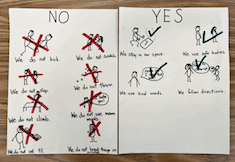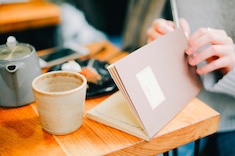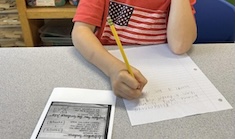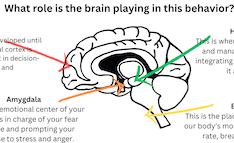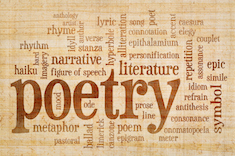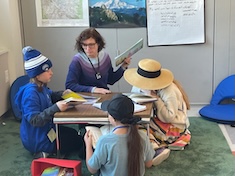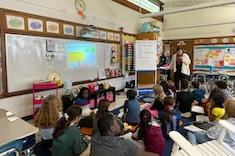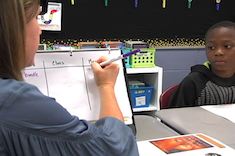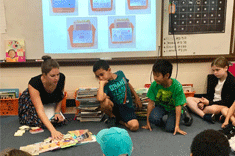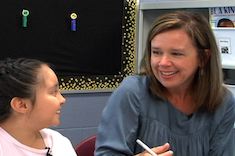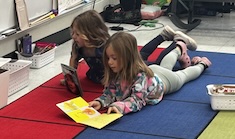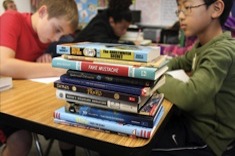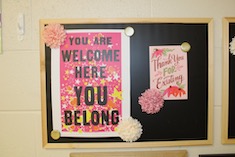Struggling and Striving Learners
It's hard work, it matters . . . and nothing brings more joy than reaching a child who is struggling. The problem is each of these students presents a unique array of challenges and needs that don't allow for a uniform approach. Here are the stories from our contributors of their breakthrough moments, one child at a time.
Latest Content
Those Pictures You Make: Personalized Tools to Help Students
Becca Burk shares how to personalize tools for students to build independence in their academics and emotional regulation.
Fostering Independence with Tools
Melissa Quimby tackles the question of how to foster more independence in her students. She considers the way tools can help scaffold independence. Melissa offers an in-depth conversation that examines what tool to create, how to introduce it, and where to store it.
Background Knowledge: More than Just Facts
Although background knowledge may feel like an “old concept,” Leigh Anne Eck offers fresh and important considerations to lift students’ ability to comprehend complex texts.
Why High School Students Need Cardboard Castles and Poetry Caves
Gretchen Schroeder makes a case for offering creative opportunities for high school students to play with language. She names three components to ensure a creative, playful experience is successful: student choice, ownership, and inspiring invitations.
Hidden Lessons: Why Do Relationships Matter? (Part 3)
By the time they reach high school, many students have learned how to survive change, but not always how to make sense of it. They’ve lost friendships, switched schools, experienced family transitions, or even dealt with grief. While they may not always talk openly about these experiences, they often find reflections of them in the books they read. Gretchen Schroeder continues her series about using literature to help students learn important social and relationship skills. She includes student work and a booklist.
An Ode to the Anchor Chart
In a world where anchor charts are becoming digitized and developed by curriculum publishers, Bitsy Parks reminds us of the power and importance of co-creating anchor charts with students. She outlines key steps and ways to adjust anchor charts to connect with students and improve engagement.
Four Ways to Use Anchor Charts in the Classroom
Tiffany Abbott Fuller provides a practical and fresh approach to organizing anchor charts in meaningful and helpful ways. Don’t miss the action-oriented summary at the end of the article to put these ideas into place in your classroom.
Hidden Lessons: Integrating Social-Emotional Learning in an Authentic Way
We know there is a need to teach more lessons about wellness, and we know that it is sometimes difficult to teach those lessons in a way that students will accept. Gretchen Schroeder offers three questions for teachers to consider as they plan to incorporate social and emotional learning standards into their classrooms. This is the first installment of a series.
What Just Happened? Download a Behavior Sheet
Becca Burk shares her new learning about how the brain responds to trauma and the way she uses neuroscience to help respond to challenging behaviors in her classroom. Download a practical behavior sheet to help guide your responses to tricky behaviors.
Rhyme and Reflect: Fostering Fluency Through Poetry
Joanne Emery recommends using poetry to help children practice their oral expression. She offers many poetry books and strategies for fluency practice.
What Is ORF Anyway?
Dana Murphy reminds us that teaching students to read faster is often a surface-level answer to a much deeper question. Reading is a complex process; if you’re wondering what to do about oral reading fluency scores, then Dana offers powerful encouragement.
Helping Kids Lead Every Day: Differentiate with Precision
Tammy Mulligan shares three ways to precisely differentiate small-group instruction. This is the third installment of a three-part series.
One Size Does Not Fit All: Flexibility in Tool Creation
Sometimes, we ask students to conform to tools that we’ve already created or have found success with when working with former groups of students. However, one size does not fit all. Melissa Quimby shows us how we can be inspired by moments of productive struggle and consider how to help a tool fit our students rather than the other way around.
How to Intensify an Intervention
What happens when students’ reading data takes a downward trend? Dana Murphy encourages us to be confident and intensify a reading intervention with three practical moves.
Leading with Empathy in the Classroom
Melissa Quimby offers profound advice for what to do when we notice inattention, excessive questioning, frozen learners, or disruptive behaviors. She recommends letting empathy lead our next steps.
Responding to Dysregulated Behavior: How to Move Forward
Becca Burk shares how to move forward in healthy ways after the extreme situation of a student dislocating her knee. This is the final installment of a four-part series chronicling the responses when a student with dysregulated behaviors joins Becca’s kindergarten class mid-year.
My Student Is Risk Averse
Molly James explains the difference between shyness and risk aversion.
Responding to Dysregulated Behaviors: What about the other kids?
Becca Burk reflects on the other kids in the classroom who witness dysregulated behaviors from a classmate. She reminds us of the way grace and acceptance are prominent when we look for the silver linings in difficult situations. This is the third installment of a four-part series chronicling the responses when a student with dysregulated behaviors joins Becca Burk’s kindergarten class mid-year.
Responding to Dysregulated Behaviors: A Symptom of What?
When a new student spirals into anxiety and becomes aggressive, Becca Burk finds herself with a dislocated knee and advocating for the student to return to the classroom. This is the second installment of a four-part series chronicling the responses when a student with dysregulated behaviors joins Becca Burk’s kindergarten class mid-year.
Responding to Dysregulated Behaviors: “What’s a Book?”
When a new student joins Becca Burk’s kindergarten classroom and asks, “What’s a book?” Becca realizes some behaviors are new to even the most veteran teachers. This is the first installment of a four-part series chronicling the responses when a student with dysregulated behaviors joins Becca Burk’s kindergarten class mid-year.
Responding to Appeals for Help
Dana Murphy outlines three options to respond to a student who is stuck when reading and looking to the teacher for the answer. By being mindful when students appeal for help, we can make intentional, on-the-spot decisions to empower students to become better readers.
Teaching Students to Self-Monitor
Dana Murphy explicitly teaches students how to self-monitor through modeling and using an anchor chart that clearly defines each step.
Fostering a Love of Reading in All Students
Lisa Mazinas reminds us of the importance of fostering a love of reading in all students. She offers specific ways to reconnect students with the enjoyment of reading.
Know/Wonder Chart
Dana Murphy shares the power of a Know/Wonder chart to peek inside the minds of intermediate readers and provide direction beyond assessment data.
Morning Message 4: Application and Differentiation
The possibilities for differentiation during morning message are almost endless. Ruth Metcalfe highlights ways to meet a wide variety of needs via the morning message.
Developing Reader Identities: It Is More Than Magic
Becca Burk reminds us of the importance of building a reading identity within all students so they can become stronger readers.
When They’re Hard to Teach
Cathy Mere reminds us of the complexities of teaching readers, especially those who are in intervention. She shares the “rules” she’s put in place for herself when a rough patch is hit and little growth is gained.
When Reading Practices Drift
When Leigh Anne Eck noticed her students’ reading practices weren’t as robust as she expected, she realized she was the one who had drifted away from key instructional practices. Leigh Anne offers several ways to support students in their independent reading lives.
Detours: A Reminder of the Humanity of Students
Gretchen Schroeder reminds us of the importance of checking in with students and gauging how they are feeling—and then responding with authenticity and joy.
Increasing Student Choice
We want students to be lifelong learners, eager to grow, and equipped to face challenges. For this to happen, we have to let the classroom be a place that reflects these qualities. Julie Cox offers three innovative ways to leave choice in the hands of students. In turn, they learn to trust themselves and their learning, and believe that they are capable of finding answers.
Browse Content By
Type
Category
- Assessment Tools
- Big Fresh Archives
- Booklists
- Choice Numeracy
- Classroom Design
- Common Core
- Community Building
- Conferring
- Content Literacy
- Digital Literacy
- English Language Learners
- Equity
- Family Relations
- Free Samples
- Guiding Groups
- Leadership
- Literacy Coaches
- Mentor Texts
- Minilessons
- New Teacher Mentors
- Podcasts
- Poetry
- Quote Collections
- Reading Strategies
- Self Care
- Struggling and Striving Learners
- Talking and Listening
- Teacher Study Groups
- Teaching Reading
- Teaching Writing
- Word Study and Vocabulary
Author
- Melissa Quimby
- Nawal Qarooni
- Gwen Blumberg
- Julie Cox
- The Lead Learners
- Hannah Tills
- Josie Stewart
- Ruth Metcalfe
- Mallory Messenger
- Becca Burk
- Jodie Bailey
- Vivian Chen
- Mary Brower
- Tiffany Abbott Fuller
- Stephanie Affinito
- Ruth Ayres
- Leigh Anne Eck
- Heather Fisher
- Shari Frost
- Julie Johnson
- Suzy Kaback
- Gigi McAllister
- Shirl McPhillips
- Melanie Meehan
- Cathy Mere
- Debbie Miller
- Tara Barnett and Kate Mills
- Tammy Mulligan
- Dana Murphy
- Bitsy Parks
- David Pittman
- Brenda Power
- Heather Rader
- Matt Renwick
- Mandy Robek
- Christy Rush-Levine
- Gretchen Schroeder
- Jen Schwanke
- Brian Sepe
- Katherine Sokolowski
- Stella Villalba
- Jennifer Vincent
Grade Level
Choice Literacy Membership
Articles
Get full access to all Choice Literacy article content
Videos
Get full access to all Choice Literacy video content
Courses
Access Choice Literacy course curriculum and training

